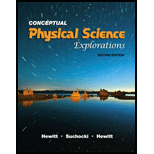
Concept explainers
Which of the geologic time units spans the greatest length of time?
The geologic time units span the greatest length of the time.
Answer to Problem 7RQ
Eons are the unit of geological time and they span the greatest length of time.
Explanation of Solution
The Chronological order of the time for the history of Earth is called the geologic time scale. This scale developed on the basis of the relative ages of different rock layers and their traces. And the Geologic time scale partitions the Earth's 4.5-billion year history into the time units of different intervals.
The largest unit of geologic time is Eons. Eons are part of the Precambrian time. The Eons that we are living was started about 543 million years ago, known as Phanerozoic eon. And the Eons are further divided into shorter time intervals, known as eras.
Conclusion:
Therefore, the eons are the unit of geological time and they span the greatest length of time.
Chapter 29 Solutions
Conceptual Physical Science Explorations
Additional Science Textbook Solutions
Physics for Scientists and Engineers with Modern Physics
College Physics: A Strategic Approach (3rd Edition)
University Physics Volume 1
Glencoe Physical Science 2012 Student Edition (Glencoe Science) (McGraw-Hill Education)
Conceptual Integrated Science
 College PhysicsPhysicsISBN:9781305952300Author:Raymond A. Serway, Chris VuillePublisher:Cengage Learning
College PhysicsPhysicsISBN:9781305952300Author:Raymond A. Serway, Chris VuillePublisher:Cengage Learning University Physics (14th Edition)PhysicsISBN:9780133969290Author:Hugh D. Young, Roger A. FreedmanPublisher:PEARSON
University Physics (14th Edition)PhysicsISBN:9780133969290Author:Hugh D. Young, Roger A. FreedmanPublisher:PEARSON Introduction To Quantum MechanicsPhysicsISBN:9781107189638Author:Griffiths, David J., Schroeter, Darrell F.Publisher:Cambridge University Press
Introduction To Quantum MechanicsPhysicsISBN:9781107189638Author:Griffiths, David J., Schroeter, Darrell F.Publisher:Cambridge University Press Physics for Scientists and EngineersPhysicsISBN:9781337553278Author:Raymond A. Serway, John W. JewettPublisher:Cengage Learning
Physics for Scientists and EngineersPhysicsISBN:9781337553278Author:Raymond A. Serway, John W. JewettPublisher:Cengage Learning Lecture- Tutorials for Introductory AstronomyPhysicsISBN:9780321820464Author:Edward E. Prather, Tim P. Slater, Jeff P. Adams, Gina BrissendenPublisher:Addison-Wesley
Lecture- Tutorials for Introductory AstronomyPhysicsISBN:9780321820464Author:Edward E. Prather, Tim P. Slater, Jeff P. Adams, Gina BrissendenPublisher:Addison-Wesley College Physics: A Strategic Approach (4th Editio...PhysicsISBN:9780134609034Author:Randall D. Knight (Professor Emeritus), Brian Jones, Stuart FieldPublisher:PEARSON
College Physics: A Strategic Approach (4th Editio...PhysicsISBN:9780134609034Author:Randall D. Knight (Professor Emeritus), Brian Jones, Stuart FieldPublisher:PEARSON





